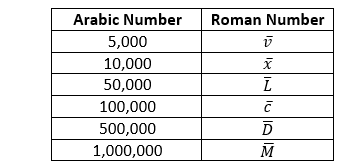Roman Numerals
Ancient Romans used a special notation to represent the numbers is known as roman numerals. It is an ancient way of writing numbers that originated in ancient Rome.
The Romans had developed roman numerals for trading purposes so that they can price different goods and services. At the present time, the roman numbers were used throughout the Roman Empire in daily life.
Roman Numerals Symbol
There are seven different letters to represent roman numerals. These letters are used to make thousands of numbers. We can write roman numerals in uppercase and lowercase letters. The following table represents the number and corresponding roman numerals in upper and lowercase letters.
| Arabic Number | 1 | 5 | 10 | 50 | 100 | 500 | 100 |
| Uppercase Representation | I | V | X | L | C | D | M |
| Lowercase Representation | i | v | x | l | c | d | m |
Basic Combinations of Roman Numerals
| 1 | 2 | 3 | 4 | 5 | 6 | 7 | 8 | 9 |
| I | II | III | IV | V | VI | VII | VIII | IX |
| 10 | 20 | 30 | 40 | 50 | 60 | 70 | 80 | 90 |
| X | XX | XXX | XL | L | LX | LXX | LXXX | XC |
| 100 | 200 | 300 | 400 | 500 | 600 | 700 | 800 | 900 |
| C | CC | CCC | CD | D | DC | DCC | DCCC | CM |
Note: There is no symbol for zero.
Rules of Conversion
- The symbol is added if the symbol appears after a larger or equal symbol. Consider the following example:
VIII = V + III = 5 + 3 = 8It means that the symbol III (three) appears after the symbol V (five) and V is larger than III, so we have added the symbol.
Consider another example:LVI = L + V + I = 50 + 5 + 1 = 56In the above example, the symbol V and I appear after the symbol L and L is larger than V and I, so we have added the symbol.
- The symbol is subtracted if the symbol appears before a larger symbol. Consider the following example:
IV = V – I = 5 – 1 = 4In the above example, the symbol I appear before the larger symbol V. It means we have to subtract the symbol I form the symbol V. Therefore, the symbol IV represents 4.
Consider another example:XLIV = L – X + V – I = 50 -10 + 5 – 1 = 44Let’s understand the above example carefully.
In the above example, there are four symbol X, L, I, V, having values 10, 50, 1, and 5, respectively. The symbol L is the largest symbol among them. The symbol X appears before the symbol L, so we have to subtract the symbol X from the symbol L. It means:L – X = 50 -10 = 40Similarly, the symbol I appears before the symbol V, so we have to subtract the symbol I from the symbol V. It means:
V – I = 5 -1 = 4Now we will add 4 to the 40 because the value 4 appears after the larger symbol. Therefore, the symbol XLIV represents the number 44.
Remember: In roman numerals, the same symbol does not use more than three times in a row. For example, we cannot use IIII to represent the 4. But in clocks, it is used.
Convert a Number into Roman Numerals
If we want to convert a number into Roman numeral, we should follow the steps given below
- First, break the given number into thousands, hundreds, tens, and
- Write the corresponding roman numerals.
- Combine the whole roman numerals.
Let’s understand the above steps through an example.
Example: Convert 1792 into roman numerals.
Break the 1792 into thousands, hundreds, tens and ones.
Write the corresponding roman numerals, separately.
DCC XC II
Combine the whole numeral numbers.
Representation of Large Roman Numerals
If the number is greater than 1,000, draw a bar or line over the symbol. It represents that the number is 1000 times. It is not widely used.
For example, if we want to represent 5,000 in the roman numeral, first write the roman representation of 5 that is V and draw a bar over the symbol that is v. The symbol v represents 5,000.
Similarly, we can put a bar on any roman numeral to represent a big number. In the following list, we have listed some large numbers.

Consider the above table:
M represents the 1,000, and the bar represents 1000 times of the number. It means 1000 times of the 1,000 i.e. 1,000,000. So, the symbol M represents the ten lakhs in roman numeral.
Zero and Fractions
In roman numerals, fractions were usually used in currency. The most commonly used fractions were twelfths and halves. A dot (•) represents the twelfth. It is known as uncia. The Latin letter S represents a half, which means semis.
Remember that there is no roman numeral to represent zero. It is because the roman numerals developed for trading, and there was no need to represent zero. They were used a Latin word nulla to represent the zero.
Uses of Roman Numerals
Roman numerals are used in our daily life. We can find it in the following places:
- It is used in books to represent page numbers of primary pages.
- It is used in fancy clocks and watches.
- It is also used in sequels of films, books, and games.
- To represent the historical events. For example, World War II.
- The Monarchs are usually numbered in romans. For example, Louis XIV of France.
- Royal families also use this system to represent their names if the two people have the same name in the family. For example, in a family, the son’s name is Paul Jones, and his father and grandfather were also named Paul Jones, then the name will be Paul Jones I (grandfather), Paul Jones II (father), and Paul Jones III (son).
Roman Numerals Chart
| 1 | I | 26 | XXVI | 51 | LI | 76 | LXXVI |
| 2 | II | 27 | XXVII | 52 | LII | 77 | LXXVII |
| 3 | III | 28 | XXVIII | 53 | LIII | 78 | LXXVIII |
| 4 | IV | 29 | XXIX | 54 | LIV | 79 | LXXIX |
| 5 | V | 30 | XXX | 55 | LV | 80 | LXXX |
| 6 | VI | 31 | XXXI | 56 | LVI | 81 | LXXXI |
| 7 | VII | 32 | XXXII | 57 | LVII | 82 | LXXXII |
| 8 | VIII | 33 | XXXIII | 58 | LVIII | 83 | LXXXIII |
| 9 | IX | 34 | XXXIV | 59 | LIX | 84 | LXXXIV |
| 10 | X | 35 | XXXV | 60 | LX | 85 | LXXXV |
| 11 | XI | 36 | XXXVI | 61 | LXI | 86 | LXXXVI |
| 12 | XII | 37 | XXXVII | 62 | LXII | 87 | LXXXVII |
| 13 | XIII | 38 | XXXVIII | 63 | LXIII | 88 | LXXXVIII |
| 14 | XIV | 39 | XXXIX | 64 | LXIV | 89 | LXXXIX |
| 15 | XV | 40 | XL | 65 | LXV | 90 | XC |
| 16 | XVI | 41 | XLI | 66 | LXVI | 91 | XCI |
| 17 | XVII | 42 | XLII | 67 | LXVII | 92 | XCII |
| 18 | XVIII | 43 | XLIII | 68 | LXVIII | 93 | XCIII |
| 19 | XIX | 44 | XLIV | 69 | LXIX | 94 | XCIV |
| 20 | XX | 45 | XLV | 70 | LXX | 95 | XCV |
| 21 | XXI | 46 | XLVI | 71 | LXXI | 96 | XCVI |
| 22 | XXII | 47 | XLVII | 72 | LXXII | 97 | XCVII |
| 23 | XXIII | 48 | XLVIII | 73 | LXXIII | 98 | XCVIII |
| 24 | XXIV | 49 | XLIX | 74 | LXXIV | 99 | XCIX |
| 25 | XXV | 50 | L | 75 | LXXV | 100 | C |
